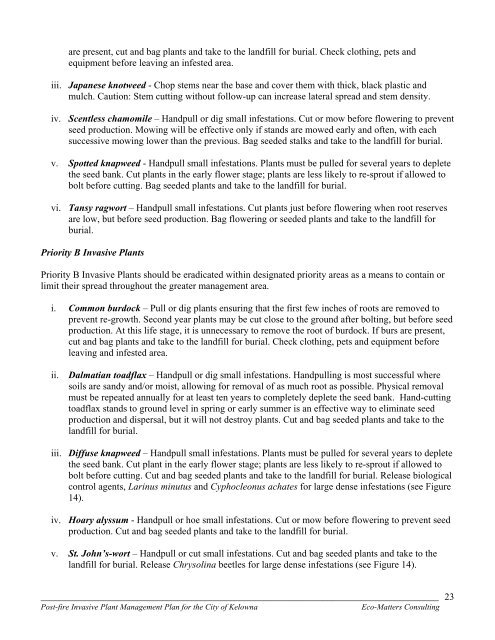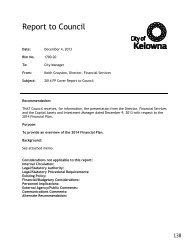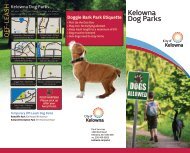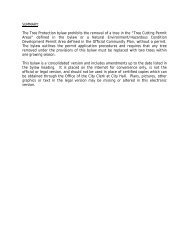WEED MANAGEMENT PLAN - City of Kelowna
WEED MANAGEMENT PLAN - City of Kelowna
WEED MANAGEMENT PLAN - City of Kelowna
Create successful ePaper yourself
Turn your PDF publications into a flip-book with our unique Google optimized e-Paper software.
are present, cut and bag plants and take to the landfill for burial. Check clothing, pets and<br />
equipment before leaving an infested area.<br />
iii. Japanese knotweed - Chop stems near the base and cover them with thick, black plastic and<br />
mulch. Caution: Stem cutting without follow-up can increase lateral spread and stem density.<br />
iv. Scentless chamomile – Handpull or dig small infestations. Cut or mow before flowering to prevent<br />
seed production. Mowing will be effective only if stands are mowed early and <strong>of</strong>ten, with each<br />
successive mowing lower than the previous. Bag seeded stalks and take to the landfill for burial.<br />
v. Spotted knapweed - Handpull small infestations. Plants must be pulled for several years to deplete<br />
the seed bank. Cut plants in the early flower stage; plants are less likely to re-sprout if allowed to<br />
bolt before cutting. Bag seeded plants and take to the landfill for burial.<br />
vi. Tansy ragwort – Handpull small infestations. Cut plants just before flowering when root reserves<br />
are low, but before seed production. Bag flowering or seeded plants and take to the landfill for<br />
burial.<br />
Priority B Invasive Plants<br />
Priority B Invasive Plants should be eradicated within designated priority areas as a means to contain or<br />
limit their spread throughout the greater management area.<br />
i. Common burdock – Pull or dig plants ensuring that the first few inches <strong>of</strong> roots are removed to<br />
prevent re-growth. Second year plants may be cut close to the ground after bolting, but before seed<br />
production. At this life stage, it is unnecessary to remove the root <strong>of</strong> burdock. If burs are present,<br />
cut and bag plants and take to the landfill for burial. Check clothing, pets and equipment before<br />
leaving and infested area.<br />
ii. Dalmatian toadflax – Handpull or dig small infestations. Handpulling is most successful where<br />
soils are sandy and/or moist, allowing for removal <strong>of</strong> as much root as possible. Physical removal<br />
must be repeated annually for at least ten years to completely deplete the seed bank. Hand-cutting<br />
toadflax stands to ground level in spring or early summer is an effective way to eliminate seed<br />
production and dispersal, but it will not destroy plants. Cut and bag seeded plants and take to the<br />
landfill for burial.<br />
iii. Diffuse knapweed – Handpull small infestations. Plants must be pulled for several years to deplete<br />
the seed bank. Cut plant in the early flower stage; plants are less likely to re-sprout if allowed to<br />
bolt before cutting. Cut and bag seeded plants and take to the landfill for burial. Release biological<br />
control agents, Larinus minutus and Cyphocleonus achates for large dense infestations (see Figure<br />
14).<br />
iv. Hoary alyssum - Handpull or hoe small infestations. Cut or mow before flowering to prevent seed<br />
production. Cut and bag seeded plants and take to the landfill for burial.<br />
v. St. John’s-wort – Handpull or cut small infestations. Cut and bag seeded plants and take to the<br />
landfill for burial. Release Chrysolina beetles for large dense infestations (see Figure 14).<br />
__________________________________________________________________________________<br />
Post-fire Invasive Plant Management Plan for the <strong>City</strong> <strong>of</strong> <strong>Kelowna</strong><br />
Eco-Matters Consulting<br />
23

















